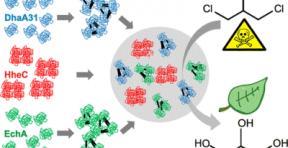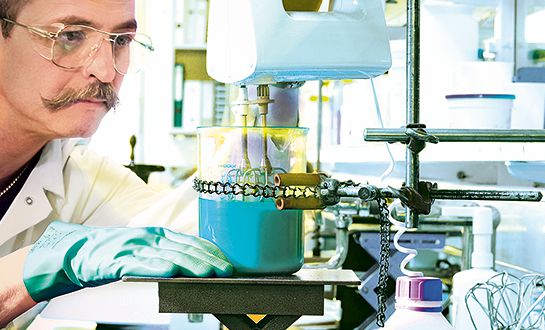It's known that 1,2,3-trichloropropane is a substance that pollutes the environment and worries specialists in environmental protection for a long time. A substance that is supposed to be carcinogenic, often penetrates into the groundwater, and still there is no effective method for purification of water from 1,2,3-trichloropropane.
However, chemists have developed a new technique that enables to use three enzymes and convert hazardous substance in glycerin.
Each year all around the word there produced approximately about 50,000 tons of 1,2,3- trichloropropane, which is used as an industrial solvent , as well as a precursor for fumigants . Since previous studies have shown that 1,2,3-trichloropropane can cause cancer to animals , and recently this substance was detected in drinking water, the Agency of the U.S. Environmental Protection plans to develop the rules governing the environmental aspects associated with 1,2,3- trichloropropane.

Three enzymes (red, blue and green) turns toxic 1,2,-3-trichloropropane into glycerin.
As it was noted by Zbyn?k Prokop, a specialist in environmental chemistry from the Masaryk University (Czech Republic) - he says that there is no cost-effective method of processing 1,2,3-trichloropropane, and it is also can't be decayed in nature (despite numerous research); the researchers haven't succeeded to detect an organism that could metabolize 1,2,3-trichloropropane. The last circumstance is related with high durability of the carbon-chlorine compound and with great toxicity to microorganisms.
Researchers in the group, headed by Prokop, developed a five-step process, that allows to convert 1,2,3-trichloropropane in glycerin with the help of three enzymes secreted by the two types of soil bacteria. In the first stage halogenoalkane collagenase secreted by Rhodococcus rhodochrous organism, contributes the substitution of a chlorine atom in the 1,2,3-trihlorpropane into hydroxyl group and it contributes the formation of 2,3-dichloropropane-1-ol. The following four steps occur with halogenoalkane collagenase and epoxide hydrolase produced by Agrobacterium radiobacter.
These enzymes allow to replace two remaining chlorine atoms into hydroxyl groups, and such replacement flows with the intermediate formation of epoxides .
In the process mode one-pot three enzymes contributed to the complete conversion of 5 mM 1,2,3- trichloropropane into glycerin for 30 hours . Researchers have also immobilized enzymes incorporated them into particles of a hydrogel of polyvinyl alcohol, and loaded fixed bed reactor with these particles. In this reactor, 10 grams of 1,2,3- trichloropropane felt under complete conversion within 2.5 months.
In the course of studying, each of the enzymes was obtained in a different way using genetically modified Escherichia coli, although , according to Prokop , there is a possibility in such modification to let one strain synthesize all three enzymes. Nevertheless , the researcher suggests that it's better use the enzymes out of microorganism and primarily to solve the problem of toxicity of 1,2,3- trihlorpropane for the simplest , and the use of genetically modified micro-organisms, even for cleaning the environment from pollutants , is prohibited under a number of countries .




